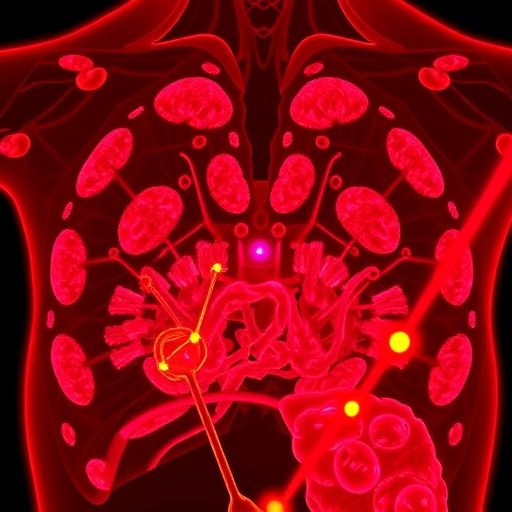In a groundbreaking study published in BioMedical Engineering OnLine, researchers have unveiled critical insights into the role of m6A RNA methylation regulators within the tumor immune microenvironment of prostate cancer (PC). This study focusses on two pivotal m6A regulatory proteins, YTHDF1 (YTH N6-methyladenosine RNA binding protein 1) and IGFBP2 (insulin-like growth factor binding protein 2), and how their expression levels correlate with prognosis in prostate cancer patients. The findings underscore these factors as potent prognostic biomarkers with significant implications for therapeutic strategies.
Prostate cancer remains one of the most prevalent and lethal malignancies affecting men worldwide. The immune microenvironment of tumors — comprising immune cells, signaling molecules, and the extracellular matrix — plays a crucial role in tumorigenesis, progression, and treatment resistance. Epigenetic modifications, particularly RNA methylation, have emerged as key modulators impacting gene expression and immune responses. Notably, N6-methyladenosine (m6A) is the most abundant internal modification on messenger RNA (mRNA), regulating RNA stability, splicing, translation, and degradation.
The research team collected tissue samples from prostate cancer patients undergoing surgical resection. Both tumor tissues and adjacent non-cancerous tissues were subjected to detailed immunohistochemical analyses to detect and quantify the expression of YTHDF1 and IGFBP2. The localization of these proteins was restricted predominantly to the cytoplasm of cancer cells, highlighting their functional relevance at the post-transcriptional level in tumor cells.
Quantitative analysis revealed a marked overexpression of YTHDF1 and IGFBP2 in prostate cancer tissue compared with adjacent normal tissue. Specifically, 69.81% of cancer tissues displayed positive YTHDF1 expression, dramatically higher than 33.96% in non-tumorous tissues. Similarly, IGFBP2 was overexpressed in 62.26% of cancer specimens relative to 28.30% in surrounding tissue. These statistically significant differences (p < 0.01) indicate that m6A regulation is intimately linked with prostate oncogenesis.
Delving deeper into clinical parameters, the researchers correlated YTHDF1 and IGFBP2 expression with established prognostic factors such as tumor-node-metastasis (TNM) stage, Gleason score, and prostate-specific antigen (PSA) levels. Positive expression of both YTHDF1 and IGFBP2 was significantly associated with higher TNM stages (III and IV), elevated Gleason scores, and PSA levels exceeding 15 ng/mL. This strong association suggests that these m6A regulators may actively contribute to tumor aggressiveness and metastatic potential.
From a survival analysis perspective, patients exhibiting elevated YTHDF1 expression had a median survival time of only 35 months, substantially lower than the 44 months observed in patients without YTHDF1 expression. Likewise, the IGFBP2 positive group showed a median survival of 32 months compared to 45 months in negative counterparts. These observations underline the prognostic weight that these m6A regulatory proteins carry, potentially outperforming conventional indicators in predicting patient outcomes.
Statistical modeling employing logistic regression further established that YTHDF1 and IGFBP2, along with TNM stage, Gleason score, and PSA, independently predicted poor prognosis in prostate cancer patients. This independence emphasizes that m6A regulators add novel and non-redundant prognostic value which may facilitate more nuanced and personalized patient management.
Mechanistically, YTHDF1 is known to promote mRNA translation by recognizing m6A modifications, thus modulating the expression of oncogenes or tumor suppressors post-transcriptionally. IGFBP2 modulates insulin-like growth factor signaling pathways implicated in cell proliferation, survival, and migration. Their overexpression in prostate cancer likely disrupts normal cell regulatory networks, fostering a more immunosuppressive and tumorigenic microenvironment.
Importantly, the immune microenvironment itself is a dynamic and critical player in prostate cancer progression. The study’s findings suggest that altered m6A methylation status mediated by YTHDF1 and IGFBP2 may shape immune cell infiltration, cytokine profiles, and overall tumor-immune interactions. This immunomodulatory potential elevates these proteins as promising therapeutic targets, especially in the era of immuno-oncology.
Despite the compelling evidence, the authors caution that translation of these findings into clinical practice necessitates validation in larger cohorts and multi-center studies. The heterogeneity of prostate cancer, diverse treatment regimens, and intricacies of m6A machinery require robust investigation before these biomarkers can be integrated into prognostic algorithms or targeted therapeutics.
In summary, this study positions YTHDF1 and IGFBP2 at the forefront of prostate cancer research, linking m6A RNA methylation regulators to tumor progression and immune microenvironment dynamics. Their independent prognostic value and putative functional roles herald new diagnostic and therapeutic avenues, offering hope for improved survival outcomes in patients suffering from this prevalent malignancy.
As research into m6A epitranscriptomics and immune microenvironment interactions rapidly evolves, the integration of such molecular biomarkers promises to transform the landscape of precision oncology. This study is a crucial step toward unraveling the complex biology underpinning prostate cancer progression and may soon catalyze the development of novel interventions targeting m6A-mediated pathways.
Subject of Research: Prostate cancer; role of m6A RNA methylation regulators YTHDF1 and IGFBP2 in tumor immune microenvironment and prognosis.
Article Title: Influence of m6A regulatory factor related to immune microenvironment on the prognosis of prostate cancer.
Article References:
Zhu, W., Liu, Z., Wang, S. et al. Influence of m6A regulatory factor related to immune microenvironment on the prognosis of prostate cancer. BioMed Eng OnLine 24, 124 (2025). https://doi.org/10.1186/s12938-025-01461-x
Image Credits: AI Generated




